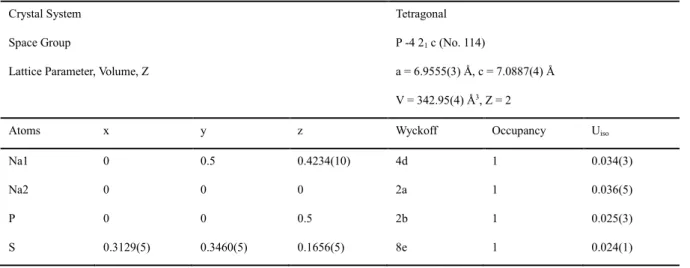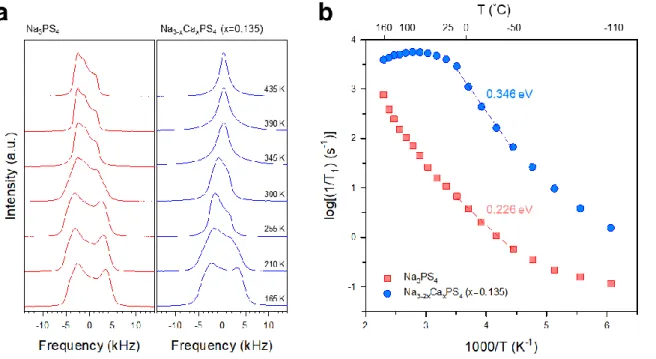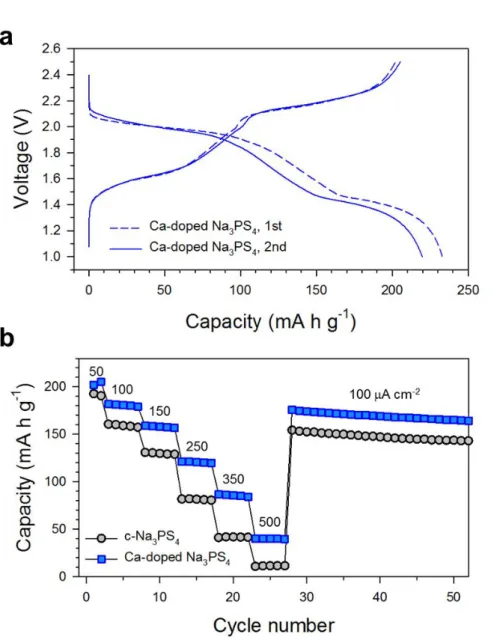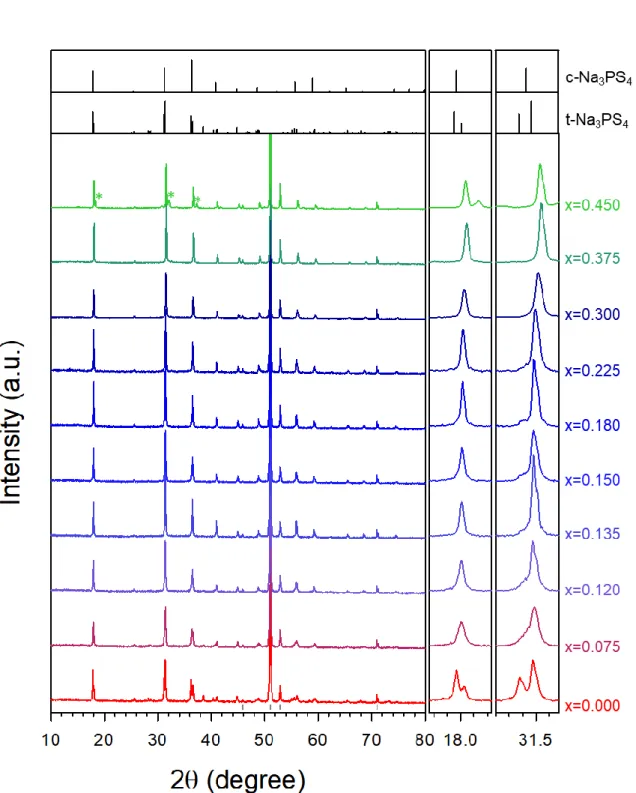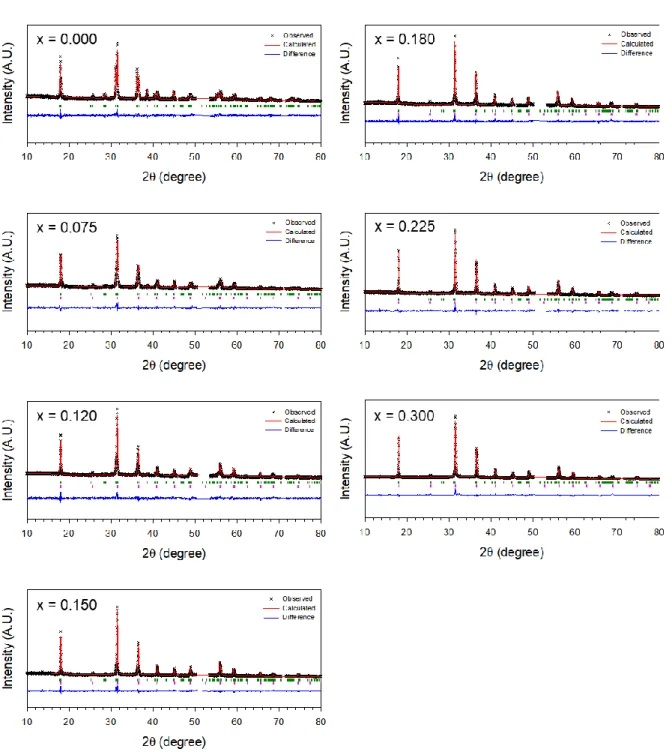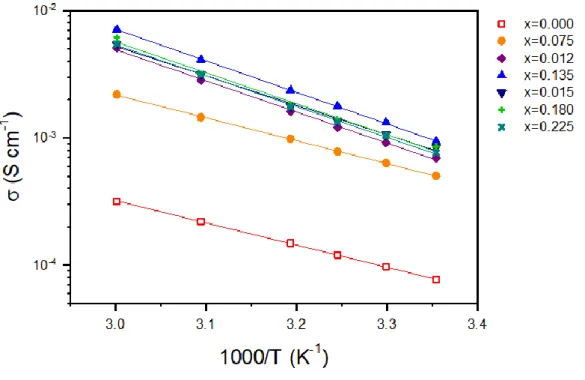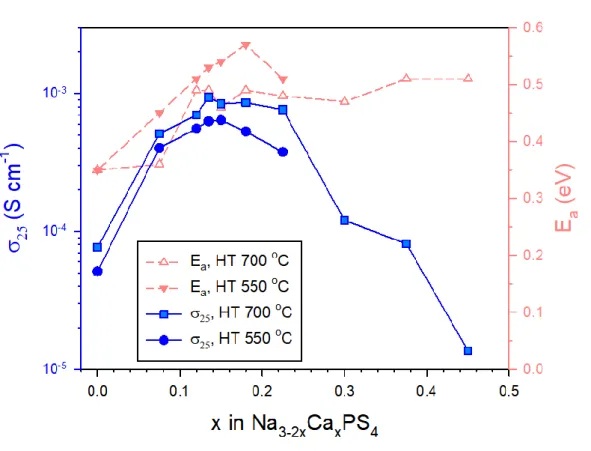Crystallographic data and Rietveld refinement results for a sample with x = 0.000 for Na3-2xCaxPS4 prepared at 700. Crystallographic data and Rietveld refinement results for a sample with x = 0.075 for Na3-2xCaxPS4 prepared at 700. Crystallographic data and Rietveld refinement results for a sample with x = 0.120 for Na3-2xCaxPS4 prepared at 700.
Crystallographic data and Rietveld refinement results for the sample with x=0.135 for Na3-2xCaxPS4 prepared at 700. Crystallographic data and Rietveld refinement results for the sample with sample with x = 0.180 for Na3-2xCaxPS4 prepared at 700.
Crystallographic data and Rietveld processing results for the sample with x = 0.225 for Na3-2xCaxPS4 prepared at 700. Crystallographic data and Rietveld processing results for the sample with x = 0.300 for Na3-2xCaxPS4 prepared at 700.
Introduction
Herein, the development of the new sodium superionic conductor in this thesis, Ca-doped cubic Na3PS4, will be presented. Aliovalent replacement of Na in t-Na3PS4 with Ca leads to the cubic phase (Na3-2xCaxPS4) and creates Na vacancies, which allows the ionic conductivity to be drastically improved to ~1 mS cm-1 at 25℃ (x = 0.135) using simple cold-press process. The fast ionic motions in Ca-doped c-Na3PS4 are investigated by 23Na solid-state nuclear magnetic resonance (NMR) spectroscopy.
Density functional theory (DFT) calculations confirm the evolution of the cubic structure by Ca-doping, the excellent Ca immobilization and the increase of the activation barrier by Ca-doping. Moreover, the promising electrochemical performance of TiS2/Na-Sn ASNBs using Na2.730Ca0.135PS4 is highlighted.
Theoretical & Mathematical Development
Principle of Lithium-ion Batteries
All-Solid-State Sodium-ion Batteries
- Inorganic and organic solid electrolytes
In contrast, solid electrolytes (SEs) do not have these disadvantages.17 Due to these characteristics, they are considered a promising candidate for large-scale energy storage systems.3-7, 10-15. This organic solid electrolyte has several advantages, such as flexibility, light weight, stability with lithium metal, good processability, low shear modulus, high resistance to volume changes of the electrodes in the cell.7, 9 However, there are also some disadvantages. The critical disadvantage is the low ionic conductivity at room temperature S cm-1).33 Therefore, most organic SEs must be used at relatively high temperatures (at least in the case of inorganic SEs, in contrast, they have higher ionic conductivity at room temperature and thermal stability compared with organic SEs.
Furthermore, they can be handled in the atmosphere and have high electrochemical stability.7 However, it is difficult to apply the oxide SEs to bulk-type ASNBs, due to their high interfacial resistance between electrolytes and electrodes.32, 40-41 For the solution this problem a sintering process is performed. Unfortunately, after this process, although the interfacial resistance is significantly reduced, undesirable side reactions occur.40-41 Therefore, the oxide SEs are not suitable for bulk-type ASNBs. In contrast to these oxide SEs, the sulfide SEs are suitable for bulk-type ASNBs due to their deformability.10, 32 The bulk-type ASNBs using sulfide SEs are produced by a simple cold-press method.10, 32 Therefore there are no side reactions during the manufacturing process.
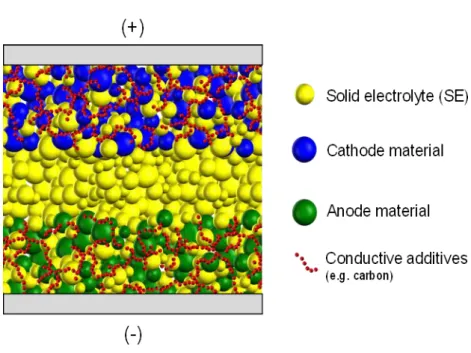
Experimental Method & Materials
- Preparation of Materials
- Materials Characterization
- Computational details
- Electrochemical Characterization
The MD simulations were taken on the canonical ensemble and the time step was set to 0.2 ps. After the Na3-2xCaxPS4 grains were prepared by cold pressing at 370 MPa, the ionic conductivity was measured by an AC impedance method using an Iviumstat (IVIUM Technologies Corp.) with symmetrical Na ion blocking Ti/ Na3-2xCaxPS4/Ti cells. Na3Sn prepared by mixing Na metal (Sigma Aldrich) with Sn metal powders (Sigma Aldrich) served as the counter electrode, with an operating voltage of ∼0 V (versus Na/Na+).
10 mg of the prepared electrodes were spread on the separating solid electrolyte layer, followed by pressing at 370 MPa. Then 50 mg of the as-prepared Na3Sn was attached to the other side of the separating solid electrolyte layer by pressing at 370 MPa. All the procedures were performed in a polyaryl ether ether ketone (PEEK) mold (diameter = 13 mm) with two Ti metal rods as current collectors.
All processes for the fabrication of all-solid-state cells were carried out in a dry box filled with Ar.
Results & Discussion
The changes in Na-ion conductance at 25 oC as a function of Ca substitution (x) in the Na3-2xCaxPS4 array, measured by the AC impedance method using symmetric ion-blocking Ti/Na3-2xCaxPS4/Ti cells, are shown in Fig. 3e (Nyquist plots and Arrhenius conductance plots are shown in the inset of Fig. 3e and Fig. S3, respectively). Despite the increase in conductivity by Ca doping, the activation energies for Ca-doped Na3PS (eV) have been shown to be higher than other superionic conductors (typically 0.2–0.3 eV)3 and, surprisingly, even higher than for t-Na3PS4 (0.35 eV), which will be discussed in a later section. In this context, the parabolic conductance curve as a function of Ca doping amount (x) in Na3-2xCaxPS4 in Fig. 3e could be related to the nc(1-nc) site occupancy function. d) Calculated formation energy as a function of c/a ratio, modified by Ca doping and VNa concentration.
The other symbols represent concentrations of vacancies and positions of Ca and VNa for Ca-doped Na3PS4; Na2.750Ca0.125PS4 (triangle up and down in red). by the experiment16 and the calculation respectively. e) Conductivity of Na ions at 25 oC and activation energies for Na3-2xCaxPS4. At a low temperature of 165 K, both spectra show broad complex asymmetric signals, which are attributed to second-order quadrupolar and dipolar interactions.25 As the temperature increases, the broad spectra become narrower, which is referred to motion constriction.25, 43 For Cadoped Na3PS4, the spectra at 345 K show a symmetric peak, which could be interpreted as the mobility of Na ions high enough to average out the quadrupolar and dipolar interactions. Moreover, the activation energy for Na ion diffusion in t-Na3PS4 and Ca-doped Na3PS4, obtained from the slope of log[1/T1] as a function of 1000/T (Figure 4b), appears to be 0.226 and 0.346 eV. , respectively.25 These values are lower than those obtained by the AC method (0.35 and 0.49 eV, respectively, Figure 3e), which is reasonable considering the additional contributions such as electrode-electrolyte interfacial and grain boundary resistances for the AC method.19 Importantly, in line with the AC impedance results (Figure 3e), the anomalous behavior of higher activation energies of Na ion diffusion for Ca-doped Na3PS4 than that for t-Na3PS4 is confirmed by the 23Na NMR results (Figure 4b).
Finally, using the Einstein–Smoluchowski equation, the self-diffusion coefficient for Ca-doped Na3PS4 is calculated at 360 K, where 1/T1 reaches its maximum value, cm2 s–1.25 The Nernst–Einstein relation then gives the corresponding ionic conductivity of 11 mS cm–1. In this regard, the result for Ca-doped Na3PS4 of increased conductivities with increased energy barriers is unusual. The activation energies are shown in (b). In order to understand this anomalous behavior of Ca-doped Na3PS4, the following theoretical methods were implemented; i) the pushed elastic band (NEB) method to study the effect of Ca2+ on Na+ mobility locally distributed around Ca2+, ii) ab-initio molecular dynamics (MD) to analyze the average macroscopic effect of Ca2+ on Na+ mobility throughout the systems.
Calculated migration barriers for Na vacancy (VNa) in undoped and Ca-doped Na3PS4. This is also consistent with the suggestion in the previous report that the conductivity for Na3PS4 is governed by vacancy rather than structure. However, when t-Na3PS4 has the same concentration of VNa without Ca doping (Na2.875PS4), the MSD (black) is relatively higher than that of the Ca-doped counterpart. This can be rationalized by the higher energy barrier to Na+ migration caused by Ca2+.
It is believed that the Ca-doped Na3PS4, which exhibits the high conductivity and the high activation energies, is an exceptional case where the former prevails over the latter. Overall, the decent electrochemical performances for TiS2/Na-Sn ASNBs using Na2.730Ca0.135PS4 highlight the high conductivity of Ca-doped Na3PS4 and the good compatibility between TiS2 and Ca-doped Na3PS4. Electrochemical performance of TiS2/Na-Sn ASNBs using c-Na3PS4 and Ca-doped Na3PS4.
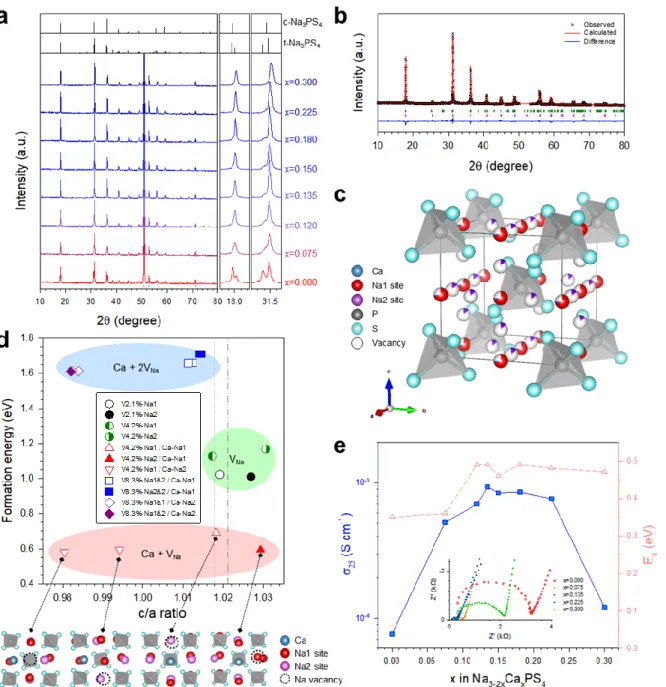
Conclusion
Supporting information
Conductivity from 23 Na NMR results
Formation energy from DFT
Supporting figures
Supporting tables
Selected interatomic distances and angles for the sample with x = 0.300 for Na3-2xCaxPS4. a) obtained in this part; b) obtained from solid synthesized samples;. Tanibata, N.; Noi, K.; Hayashi, A.; Tatsumisago, M., Preparation and characterization of Na3PS4–Na4SiS4 solid electrolytes with high sodium ion conductivity. Room-temperature solid-state solid-state sodium ion batteries with Cl-doped superionic conductor Na3PS4.
K.; Wang, D., Ultrahigh ionic conductivity in Na3P0.62As0.38S4 with improved moisture stability for solid state sodium ion batteries. Tanibata, N.; Noi, K.; Hayashi, A.; Kitamura, N.; Idemoto, Y.; Tatsumisago, M., X-ray crystal structure analysis of sodium ion conductivity in glass-ceramic electrolytes 94 Na3PS4⋅6 Na4SiS4. K.; An, K.; Liang, C., Air-Stable Na3SbS4 Superionic Conductor Prepared by a Rapid and Economical Synthetic Process.
H.; Wagemaker, M., Na-ion dynamics in tetragonal and cubic Na3PS4, a Na-ion conductor for semiconductor Na-ion batteries. Seino, Y.; Ota, T.; Takada, K.; Hayashi, A.; Tatsumisago, M., Lithium sulfide super ion conductor superior to liquid ion conductors for use in rechargeable batteries. Sakuda, A.; Hayashi, A.; Tatsumisago, M., Sulfide Solid Electrolyte with Favorable Mechanical Properties for All-Semiconductor Lithium Battery.
B; Carretero-Gonzalez, J.; Rojo, T., Naion batteries, recent developments and current challenges to become low-cost energy storage systems. G.; Janek, J., Benchmarking interfacial reactivity of the sodium ion conductors Na3PS4 and sodium beta-alumina for shielded sodium metal anodes and sodium all-solid-state batteries. Guin, M.; Tietz, F., Investigation of the transport properties of superionic sodium conductor materials for use in sodium batteries.
Guin, M.; Tietz, F.; Guillon, O., A promising new material NASICON as solid electrolyte for sodium ion batteries: correlation between composition, crystal structure and ionic conductivity of Na3+xSc2SixP3-xO12.
